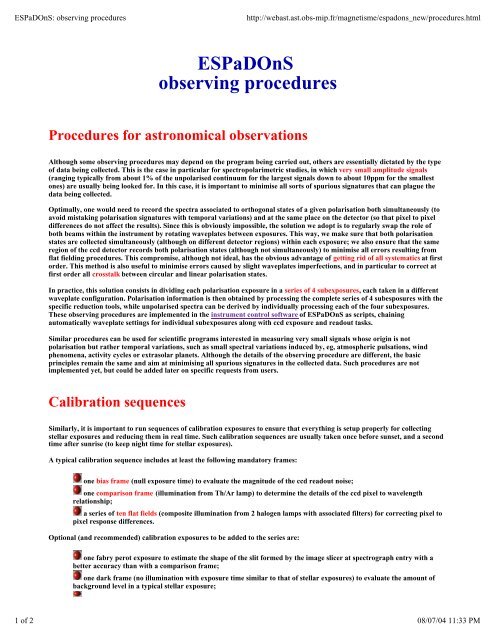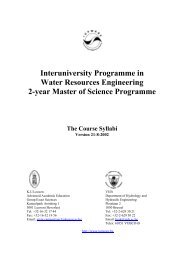CFHT operating manual - Homepage Usask
CFHT operating manual - Homepage Usask
CFHT operating manual - Homepage Usask
You also want an ePaper? Increase the reach of your titles
YUMPU automatically turns print PDFs into web optimized ePapers that Google loves.
ESPaDOnS: observing procedures http://webast.ast.obs-mip.fr/magnetisme/espadons_new/procedures.html<br />
ESPaDOnS<br />
observing procedures<br />
Procedures for astronomical observations<br />
Although some observing procedures may depend on the program being carried out, others are essentially dictated by the type<br />
of data being collected. This is the case in particular for spectropolarimetric studies, in which very small amplitude signals<br />
(ranging typically from about 1% of the unpolarised continuum for the largest signals down to about 10ppm for the smallest<br />
ones) are usually being looked for. In this case, it is important to minimise all sorts of spurious signatures that can plague the<br />
data being collected.<br />
Optimally, one would need to record the spectra associated to orthogonal states of a given polarisation both simultaneously (to<br />
avoid mistaking polarisation signatures with temporal variations) and at the same place on the detector (so that pixel to pixel<br />
differences do not affect the results). Since this is obviously impossible, the solution we adopt is to regularly swap the role of<br />
both beams within the instrument by rotating waveplates between exposures. This way, we make sure that both polarisation<br />
states are collected simultaneously (although on different detector regions) within each exposure; we also ensure that the same<br />
region of the ccd detector records both polarisation states (although not simultaneously) to minimise all errors resulting from<br />
flat fielding procedures. This compromise, although not ideal, has the obvious advantage of getting rid of all systematics at first<br />
order. This method is also useful to minimise errors caused by slight waveplates imperfections, and in particular to correct at<br />
first order all crosstalk between circular and linear polarisation states.<br />
In practice, this solution consists in dividing each polarisation exposure in a series of 4 subexposures, each taken in a different<br />
waveplate configuration. Polarisation information is then obtained by processing the complete series of 4 subesposures with the<br />
specific reduction tools, while unpolarised spectra can be derived by individually processing each of the four subexposures.<br />
These observing procedures are implemented in the instrument control software of ESPaDOnS as scripts, chaining<br />
automatically waveplate settings for individual subexposures along with ccd exposure and readout tasks.<br />
Similar procedures can be used for scientific programs interested in measuring very small signals whose origin is not<br />
polarisation but rather temporal variations, such as small spectral variations induced by, eg, atmospheric pulsations, wind<br />
phenomena, activity cycles or extrasolar planets. Although the details of the observing procedure are different, the basic<br />
principles remain the same and aim at minimising all spurious signatures in the collected data. Such procedures are not<br />
implemented yet, but could be added later on specific requests from users.<br />
Calibration sequences<br />
Similarly, it is important to run sequences of calibration exposures to ensure that everything is setup properly for collecting<br />
stellar exposures and reducing them in real time. Such calibration sequences are usually taken once before sunset, and a second<br />
time after sunrise (to keep night time for stellar exposures).<br />
A typical calibration sequence includes at least the following mandatory frames:<br />
one bias frame (null exposure time) to evaluate the magnitude of the ccd readout noise;<br />
one comparison frame (illumination from Th/Ar lamp) to determine the details of the ccd pixel to wavelength<br />
relationship;<br />
a series of ten flat fields (composite illumination from 2 halogen lamps with associated filters) for correcting pixel to<br />
pixel response differences.<br />
Optional (and recommended) calibration exposures to be added to the series are:<br />
one fabry perot exposure to estimate the shape of the slit formed by the image slicer at spectrograph entry with a<br />
better accuracy than with a comparison frame;<br />
one dark frame (no illumination with exposure time similar to that of stellar exposures) to evaluate the amount of<br />
background level in a typical stellar exposure;<br />
1 of 2 08/07/04 11:33 PM

















